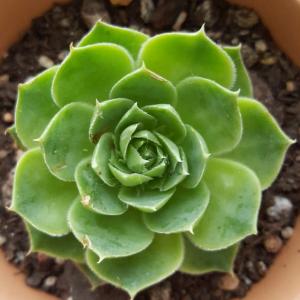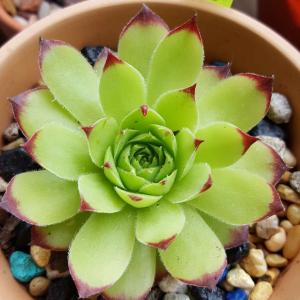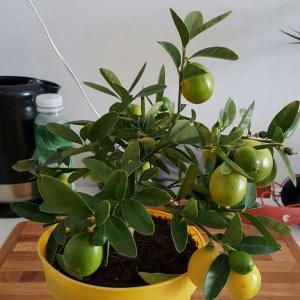求助
Cleaux
2017年05月06日

Anyone know this type of Lithops? The green one popped out of itself and I took one of the leaves off because it looked like it would attract problems, it look like it's doing well.
Do the pink ones look worrisome, or is it about to split open?
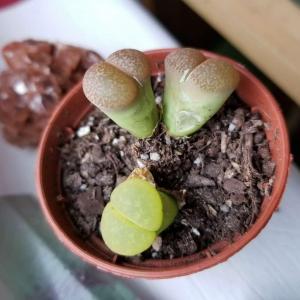
Do the pink ones look worrisome, or is it about to split open?

0
0
求助
Hong Lam
2017年03月19日

Anyone know what's going on here? Quite a few leaves are getting yellow and are drooping off, but the base and veins still look green. The rest of the plant is still nice and glossy and healthy but I don't know if this is a disease spreading or something like that.
It's a gardenia Plant. I've just started fertilizing once a week for the past two weeks. #Gardeniajasminoides #Medium

It's a gardenia Plant. I've just started fertilizing once a week for the past two weeks. #Gardeniajasminoides #Medium

0
0
我是小花:Hello! The number of fertilizing doesn't have to be too much, it can be reduced to just a few times a month! And the concentration of fertilizers must be lower. I feel that the control should be improved!
文章
lenny
2017年03月15日

These 23 (Rooftop) Terrace Garden Tips will help you in transforming your urban space into a green oasis.
You love to garden but you don’t have a piece of land. No problem, you can have a garden on the rooftop, however small. It is not necessary to abandon the idea of being able to create a natural paradise. There are many tricks and clever ideas to do this and here are a few rooftop gardening tips that’ll help you.
Terrace Garden Tips
1.

Create a theme for your rooftop garden and stick to it. Choose plants, furniture, and other accessories according to it.
2.

Creating green walls and hedges can completely transform a rooftop terrace into an unbelievable outdoor area that can even look like a regular garden. For this, create tall and dense vegetation around all the corners that will offer you total privacy and a perfect setting for outdoor dining and relaxing moments surrounded by nature.
3.

In our terrace garden tips, lighting is very important. Good lighting can enhance the beauty of the vegetation. This way you can enjoy the evening on the rooftop garden.
4.

A roof-top has a parapet or breastwork, make that low wall little high so that you can use that as a support for growing climbing plants and creepers and if you need shadow in sitting area, umbrellas in light colors are perfect.
5.

Flowering annuals can completely transform the look of any garden when they bloom all together. You can plant different species of flowers for every season. Opt for a combination of two or three colors to create a harmony is a good idea.
6.

While choosing furniture, take care that they are light, durable and must not take too much space.
7.

Although small, this rooftop garden is totally unique and appealing with the addition of two interesting things: The ivy topiary and a large mirror, which opens the view and creates the illusion of enlarged space. Adding a mirror is one of the useful rooftop gardening tips.
8.

If tall buildings surround your terrace or you have got an interesting view from there then it makes no sense to try to get privacy. Instead, concentrate on the open space and include large planters so that you can grow large trees in them.
9.

You can also make a great looking, elegant terrace or roof top garden by just growing conifers and beautiful foliage plants.
10.

Choose simple plants that love the direct sunlight and opt for designer containers. Do not make compromises– the planters are as important as what they contain.
11.

Being able to enjoy a breath of fresh air right above your urban dwelling is wonderful. With a little creativity, you can turn the rooftop garden into an outdoor living room, adding a bar or a kitchen countertop is also a good idea.
12.

Use as many natural materials as possible. For flooring use natural stones. Arrange wooden planters or construct beds using sandstone bricks. For seating you can buy tree stumps, they are inexpensive and do not take much of your space. This is a great way to create a more authentic and natural environment.
13.

Bright colorful shrubs in combination with a neutral decor will create a dazzling effect and on the contrary if you have a colorful setup and gaudy furniture, grow neutral plants.
14.

Choose a flooring style that is deep and bold and eye-catching. Keep the color combinations in mind to give a unique touch to the rooftop garden.
15.

Whitish beige is a main color here combined with blue and yellow. Don’t use so many colors. Decide three or four main colors and use their shades, if you want more.
16.
A terrace garden does not necessarily need to include a large number of plants, trees, and flowers. A manicured, lush green lawn and a couple of planters or well-maintained borders against the wall are sufficient to create an impressive style.
17.

If you have a small rooftop, it is better to have a couple of big planters rather than so many small containers, so as not to overwhelm the space or create chaos and disorder.
18.

Create raised beds all around the roof, raised beds can be metallic or made of wood. You can also construct permanent concrete raised beds. But before doing this, ensure your rooftop can bear that much weight. Read our article on how to construct a rooftop garden for more information.
19.

Don’t want to grow so many plants? Place colorful and modern furnishings to transform a small space into an attractive sitting area.
20.

Don’t forget to add a focal point on your urban terrace garden. Place something to allure the eyes. Adding the water element, through the insertion of a small fountain is a great idea, you can also create a small container pond.
21.

Maximize the seating space of your roof or terrace by fixing wooden benches along the raised beds.
22.

String lighting works wonderfully in open spaces. It enhances the small spaces. Most of the rooftops receive all day long sun and in such a case adding solar lights is a smart idea.
23.

You love to garden but you don’t have a piece of land. No problem, you can have a garden on the rooftop, however small. It is not necessary to abandon the idea of being able to create a natural paradise. There are many tricks and clever ideas to do this and here are a few rooftop gardening tips that’ll help you.
Terrace Garden Tips
1.

Create a theme for your rooftop garden and stick to it. Choose plants, furniture, and other accessories according to it.
2.

Creating green walls and hedges can completely transform a rooftop terrace into an unbelievable outdoor area that can even look like a regular garden. For this, create tall and dense vegetation around all the corners that will offer you total privacy and a perfect setting for outdoor dining and relaxing moments surrounded by nature.
3.

In our terrace garden tips, lighting is very important. Good lighting can enhance the beauty of the vegetation. This way you can enjoy the evening on the rooftop garden.
4.

A roof-top has a parapet or breastwork, make that low wall little high so that you can use that as a support for growing climbing plants and creepers and if you need shadow in sitting area, umbrellas in light colors are perfect.
5.

Flowering annuals can completely transform the look of any garden when they bloom all together. You can plant different species of flowers for every season. Opt for a combination of two or three colors to create a harmony is a good idea.
6.

While choosing furniture, take care that they are light, durable and must not take too much space.
7.

Although small, this rooftop garden is totally unique and appealing with the addition of two interesting things: The ivy topiary and a large mirror, which opens the view and creates the illusion of enlarged space. Adding a mirror is one of the useful rooftop gardening tips.
8.

If tall buildings surround your terrace or you have got an interesting view from there then it makes no sense to try to get privacy. Instead, concentrate on the open space and include large planters so that you can grow large trees in them.
9.

You can also make a great looking, elegant terrace or roof top garden by just growing conifers and beautiful foliage plants.
10.

Choose simple plants that love the direct sunlight and opt for designer containers. Do not make compromises– the planters are as important as what they contain.
11.

Being able to enjoy a breath of fresh air right above your urban dwelling is wonderful. With a little creativity, you can turn the rooftop garden into an outdoor living room, adding a bar or a kitchen countertop is also a good idea.
12.

Use as many natural materials as possible. For flooring use natural stones. Arrange wooden planters or construct beds using sandstone bricks. For seating you can buy tree stumps, they are inexpensive and do not take much of your space. This is a great way to create a more authentic and natural environment.
13.

Bright colorful shrubs in combination with a neutral decor will create a dazzling effect and on the contrary if you have a colorful setup and gaudy furniture, grow neutral plants.
14.

Choose a flooring style that is deep and bold and eye-catching. Keep the color combinations in mind to give a unique touch to the rooftop garden.
15.

Whitish beige is a main color here combined with blue and yellow. Don’t use so many colors. Decide three or four main colors and use their shades, if you want more.
16.
A terrace garden does not necessarily need to include a large number of plants, trees, and flowers. A manicured, lush green lawn and a couple of planters or well-maintained borders against the wall are sufficient to create an impressive style.
17.

If you have a small rooftop, it is better to have a couple of big planters rather than so many small containers, so as not to overwhelm the space or create chaos and disorder.
18.

Create raised beds all around the roof, raised beds can be metallic or made of wood. You can also construct permanent concrete raised beds. But before doing this, ensure your rooftop can bear that much weight. Read our article on how to construct a rooftop garden for more information.
19.

Don’t want to grow so many plants? Place colorful and modern furnishings to transform a small space into an attractive sitting area.
20.

Don’t forget to add a focal point on your urban terrace garden. Place something to allure the eyes. Adding the water element, through the insertion of a small fountain is a great idea, you can also create a small container pond.
21.

Maximize the seating space of your roof or terrace by fixing wooden benches along the raised beds.
22.

String lighting works wonderfully in open spaces. It enhances the small spaces. Most of the rooftops receive all day long sun and in such a case adding solar lights is a smart idea.
23.

0
0
文章
Colorful
2017年03月15日
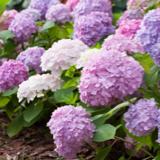
Growing garlic indoors is not difficult and you’ll be able to get the supply of fresh green stalks, flowers, and even the garlic bulbs. Learn more!
If you have ever wondered about how to grow garlic indoors then the good news is that it is going to be considerably easier than you were perhaps aware. This is something that you will be able to achieve even with next to no previous gardening experience.
What You Need and Getting Started

When to Plant Garlic Indoors
Usually, the fall is the right planting season, outdoors in our gardens it’s the time when we plant garlic. However, when growing indoors, you can try to plant garlic anytime in the year.
Choosing a Container and Spacing
Look for a pot around 8-10 inches deep, minimum and if you are planning on growing more than one bulb at a time then the pot has to be big enough to maintain a four-inch gap between each clove. Also, make sure that the pot has drainage holes in the bottom. If you’re growing garlic for its GREENS– you can grow them more closely.
You can try growing garlic indoors from the grocery store garlic but they are treated with chemicals so for the best result buy from local farmers, order them online or check out your local gardening store for the organic garlic bulbs. Also, remember that you don’t need to remove the paper like husk from cloves.Planting and Getting them Growing

The next step is to fill the pot with the organic soil mixture. You then need to remove the individual cloves from the garlic bulbs and make sure that the flat end is going to be pointing down in the soil as that is where the roots come from.
At the time of filling the soil, you can also mix time-based granular fertilizer such as 10-10-10.
When planting them, you need to push the cloves down at least 2-3 inches deep into the soil. There should also be roughly 1 inch of soil between the top of the clove and the top layer of the soil.
Placement and Caring for the Bulbs
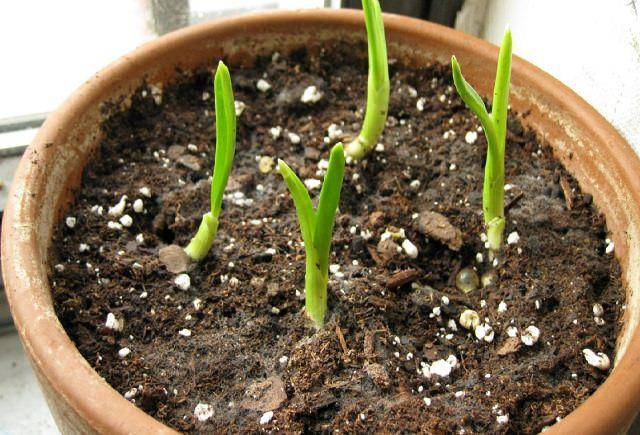
Soil
It is important that you use the right soil that is well-draining, and permeable. Soil-less potting medium is best, you can also make one for yourself instead of buying– Mix peat or cocopeat (coconut fiber), compost or manure, and either perlite or vermiculite (if you don’t have both, use sand) in equal parts.
Location
Once you have planted the bulbs decide where you should place the pot. If there is a room in your home with a South or West facing window where it can receive at least six hours of direct sunlight per day, consider that. You can also purchase indoor grow lights to make life easier and they can certainly be rather effective.
Watering
Outdoors, garlic prefers evenly moist soil, however, since you’re growing garlic indoors you may need to careful. Watering must be done according to the indoor growing conditions. Like, how much sunlight and warmth your potted garlic plants are receiving. Regular watering to keep the soil slightly moist is preferable.
Fertilizer
Garlic needs a good amount of fertilizer to grow well, indoors is no different. Fertilize the garlic plant twice a month with organic general purpose fertilizer during the warm growing season. You can also use kelp meal or fish fertilizer to ensure your garlic plant has enough nutrients for optimum growth.
HarvestingPicking Garlic Greens
With the right soil, sunlight and proper watering, in a week or so you’ll be able to see the fresh new garlic shoots coming out. You can start picking the greens once they are at least 4-6 inches tall, which will happen in a few more weeks (depending on the weather). Leave an inch of growth on each clove to let your garlic plants regrow again.
Harvesting Bulbs
If you’re growing garlic indoors for garlic bulbs, note that it’ll be ready in around eight to ten months and you will know this when you see the leaves starting to turn brown. At this point, you need to remove them from the soil and allow them to dry for a week. By this time, they will be ready to include in your cooking or, of course, you could use some of them to then grow your next batch of garlic.
If you have ever wondered about how to grow garlic indoors then the good news is that it is going to be considerably easier than you were perhaps aware. This is something that you will be able to achieve even with next to no previous gardening experience.
What You Need and Getting Started

When to Plant Garlic Indoors
Usually, the fall is the right planting season, outdoors in our gardens it’s the time when we plant garlic. However, when growing indoors, you can try to plant garlic anytime in the year.
Choosing a Container and Spacing
Look for a pot around 8-10 inches deep, minimum and if you are planning on growing more than one bulb at a time then the pot has to be big enough to maintain a four-inch gap between each clove. Also, make sure that the pot has drainage holes in the bottom. If you’re growing garlic for its GREENS– you can grow them more closely.
You can try growing garlic indoors from the grocery store garlic but they are treated with chemicals so for the best result buy from local farmers, order them online or check out your local gardening store for the organic garlic bulbs. Also, remember that you don’t need to remove the paper like husk from cloves.Planting and Getting them Growing

The next step is to fill the pot with the organic soil mixture. You then need to remove the individual cloves from the garlic bulbs and make sure that the flat end is going to be pointing down in the soil as that is where the roots come from.
At the time of filling the soil, you can also mix time-based granular fertilizer such as 10-10-10.
When planting them, you need to push the cloves down at least 2-3 inches deep into the soil. There should also be roughly 1 inch of soil between the top of the clove and the top layer of the soil.
Placement and Caring for the Bulbs

Soil
It is important that you use the right soil that is well-draining, and permeable. Soil-less potting medium is best, you can also make one for yourself instead of buying– Mix peat or cocopeat (coconut fiber), compost or manure, and either perlite or vermiculite (if you don’t have both, use sand) in equal parts.
Location
Once you have planted the bulbs decide where you should place the pot. If there is a room in your home with a South or West facing window where it can receive at least six hours of direct sunlight per day, consider that. You can also purchase indoor grow lights to make life easier and they can certainly be rather effective.
Watering
Outdoors, garlic prefers evenly moist soil, however, since you’re growing garlic indoors you may need to careful. Watering must be done according to the indoor growing conditions. Like, how much sunlight and warmth your potted garlic plants are receiving. Regular watering to keep the soil slightly moist is preferable.
Fertilizer
Garlic needs a good amount of fertilizer to grow well, indoors is no different. Fertilize the garlic plant twice a month with organic general purpose fertilizer during the warm growing season. You can also use kelp meal or fish fertilizer to ensure your garlic plant has enough nutrients for optimum growth.
HarvestingPicking Garlic Greens
With the right soil, sunlight and proper watering, in a week or so you’ll be able to see the fresh new garlic shoots coming out. You can start picking the greens once they are at least 4-6 inches tall, which will happen in a few more weeks (depending on the weather). Leave an inch of growth on each clove to let your garlic plants regrow again.
Harvesting Bulbs
If you’re growing garlic indoors for garlic bulbs, note that it’ll be ready in around eight to ten months and you will know this when you see the leaves starting to turn brown. At this point, you need to remove them from the soil and allow them to dry for a week. By this time, they will be ready to include in your cooking or, of course, you could use some of them to then grow your next batch of garlic.
2
2
文章
Abigal
2017年02月22日

No matter what time of year it is, there are times when we want to bring the beauty and gifts from the #garden indoors. Whether it’s to keep your “green thumb” warm during the winter months, because you live in a space with no outdoor gardening spot, or just because you love to have #plants indoors as well as out, here are some easy indoor gardening projects to keep you busy when you aren’t outdoors!

From ‘The Kitchn’, learn how to plant succulents in eggshells! Our feature project, above and below – This is a really organic project great for a kitchen, and especially for someone who loves to cook. Could you do the same thing with sprouts?

‘Holiday Sparkle’ shows us how to grow green onions indoors. These are great because the more you cut them, the more they grow!

Heres a project for more onions for a bigger household… make this vertical onion planter from a pop bottle! From ‘Auntie Dogmas Garden Spot‘…

From ‘Remove and Replace’, learn how to regrow romaine lettuce from that salad stump… Grow it once, never again!

‘Parents.com’ shows us how to plant an odds and ends garden, this with leftover celery. Kids love this kind of thing, fun family project.

Last, learn to grow a lemon tree indoors! From ‘The Kitchn’, this is a good tutorial on how to grow lemons indoors, and also some information on where, and what type, to buy! Find even more information on growing lemons from ‘Jim Hofman‘.

So no matter what your reason for keeping it indoors, here are a couple of projects to bring the garden to the window sill!

From ‘The Kitchn’, learn how to plant succulents in eggshells! Our feature project, above and below – This is a really organic project great for a kitchen, and especially for someone who loves to cook. Could you do the same thing with sprouts?

‘Holiday Sparkle’ shows us how to grow green onions indoors. These are great because the more you cut them, the more they grow!

Heres a project for more onions for a bigger household… make this vertical onion planter from a pop bottle! From ‘Auntie Dogmas Garden Spot‘…

From ‘Remove and Replace’, learn how to regrow romaine lettuce from that salad stump… Grow it once, never again!

‘Parents.com’ shows us how to plant an odds and ends garden, this with leftover celery. Kids love this kind of thing, fun family project.

Last, learn to grow a lemon tree indoors! From ‘The Kitchn’, this is a good tutorial on how to grow lemons indoors, and also some information on where, and what type, to buy! Find even more information on growing lemons from ‘Jim Hofman‘.

So no matter what your reason for keeping it indoors, here are a couple of projects to bring the garden to the window sill!
0
0
文章
Lisa
2017年02月20日

#Lawn care in winter is required for lush green lawn in spring. Learn how to care for it in this educative guide.
Lawn preparation for winter is one of the most important gardening task that must be done in time and correctly. Adequate fertilization, mowing and removing weeds and debris provide the lawn healthy appearance but there are a few other things you should do, which are given below.

Lawn Preparation for Winter
1. Scarification
Scarification is done to remove thatch or undergrowth from the lawn. This removes way moss, weeds and dead organic debris which impede the flow of water, air and nutrients to the roots. You can scarify your lawn in late spring when all the dangers of frost are passed or in the fall. Before scarifying your lawn, mow it. Scarify only to remove the top layer of thatch, don’t penetrate the blades too deeply.
2. Aeration
Aeration improves the airflow in the soil and reduce its compactness so that water, fertilizer and oxygen are easily absorbed by the roots. This treatment improves the condition of the roots and helps in quick regeneration of grass after the winter. Aeration should be done in fall in late September or October. However, according to a research conducted by Purdue University, aeration done too late even until the November might be helpful.
3. Liming
Generally grasses grow well in neutral pH and if your soil is acidic, do liming. Best time to lime your lawn is fall, after the aeration. The cycle of freezing and thawing in winter assists the penetration of lime into the soil.
4. Overseeding
After the aeration, if you see holes and patches apply the seeds at a rate of 0.8 Oz (25 g)/m2. Colder months are perfect time for seeding scraggly patches of lawn. It is done when soil is not frozen but cold enough to stop germination until next spring. To learn more on how to do it, read this.
5. Top Dressing
Top dressing is the process of application of thin layer of soil, sand or compost over the turf. Top dressing is done after the aeration and overseeding. It helps in leveling the surface of lawn, protect it from extreme temperatures, controls thatch, improves drainage and resistance to drought. Plus, there are many more other advantages. However, it is skipped in home gardens and lawns. To learn more about top dressing, checkout this educative article.
6. Fertilization
By proper fertilizing the lawn before winter you can increase the turf resistance to freezing temperatures. The application should be done 2-3 weeks prior to first frost date using so called “winterizer fertilizer” such as 24-2-14 NPK. But beware that winterizer should not be applied to warm season grasses as it will encourage them to grow. The high level of potassium in winterizer makes grasses more tolerant to cold and stress, helping them to survive in winter.
7. Mowing
Grass must not be cut too short or too high. Optimum height for last mowing job is leaving 2/3 of grass blades. Last mowing is best done anytime in between late October to mid November, depending more on the prevailing weather conditions. If you mow the lawn too early before winter and warm weather has made the grass to grow again, mowing must be repeated. During winters, mowing is not required. Once temperature falls below 40 F (4 C) grass starts to grow slowly.

Lawn Care in Winter
1. Weeding
To find a perfect lawn in the spring, continue weeding, even in winter. Thus, the uncontrolled growth of weeds do not choke your lawn. But rest assured, it is paradoxically easier in winter. At this time, weeds grow faster than grass. This makes them much easier to spot on – except of course, when snow covers the garden.
2. Watering
Watering the lawn in winter is almost never necessary. Nature takes care itself with the frequent rains of this period. However, if there is no rain and the grass suffers, then you can water the lawn. Choose a frost free day when temperature is above 40 F (4 C), water half an inch in the morning.
3. Cleaning
Another important step is to regularly clean the fallen leaves and debris. Fallen leaves if remain on the turf reduce its durability. Damp leaves “pressed” under a layer of snow cut off the supply of oxygen and cause rotting of the lawn. You can use this organic litter to make compost or to mulch other plants.
Lawn preparation for winter is one of the most important gardening task that must be done in time and correctly. Adequate fertilization, mowing and removing weeds and debris provide the lawn healthy appearance but there are a few other things you should do, which are given below.

Lawn Preparation for Winter
1. Scarification
Scarification is done to remove thatch or undergrowth from the lawn. This removes way moss, weeds and dead organic debris which impede the flow of water, air and nutrients to the roots. You can scarify your lawn in late spring when all the dangers of frost are passed or in the fall. Before scarifying your lawn, mow it. Scarify only to remove the top layer of thatch, don’t penetrate the blades too deeply.
2. Aeration
Aeration improves the airflow in the soil and reduce its compactness so that water, fertilizer and oxygen are easily absorbed by the roots. This treatment improves the condition of the roots and helps in quick regeneration of grass after the winter. Aeration should be done in fall in late September or October. However, according to a research conducted by Purdue University, aeration done too late even until the November might be helpful.
3. Liming
Generally grasses grow well in neutral pH and if your soil is acidic, do liming. Best time to lime your lawn is fall, after the aeration. The cycle of freezing and thawing in winter assists the penetration of lime into the soil.
4. Overseeding
After the aeration, if you see holes and patches apply the seeds at a rate of 0.8 Oz (25 g)/m2. Colder months are perfect time for seeding scraggly patches of lawn. It is done when soil is not frozen but cold enough to stop germination until next spring. To learn more on how to do it, read this.
5. Top Dressing
Top dressing is the process of application of thin layer of soil, sand or compost over the turf. Top dressing is done after the aeration and overseeding. It helps in leveling the surface of lawn, protect it from extreme temperatures, controls thatch, improves drainage and resistance to drought. Plus, there are many more other advantages. However, it is skipped in home gardens and lawns. To learn more about top dressing, checkout this educative article.
6. Fertilization
By proper fertilizing the lawn before winter you can increase the turf resistance to freezing temperatures. The application should be done 2-3 weeks prior to first frost date using so called “winterizer fertilizer” such as 24-2-14 NPK. But beware that winterizer should not be applied to warm season grasses as it will encourage them to grow. The high level of potassium in winterizer makes grasses more tolerant to cold and stress, helping them to survive in winter.
7. Mowing
Grass must not be cut too short or too high. Optimum height for last mowing job is leaving 2/3 of grass blades. Last mowing is best done anytime in between late October to mid November, depending more on the prevailing weather conditions. If you mow the lawn too early before winter and warm weather has made the grass to grow again, mowing must be repeated. During winters, mowing is not required. Once temperature falls below 40 F (4 C) grass starts to grow slowly.

Lawn Care in Winter
1. Weeding
To find a perfect lawn in the spring, continue weeding, even in winter. Thus, the uncontrolled growth of weeds do not choke your lawn. But rest assured, it is paradoxically easier in winter. At this time, weeds grow faster than grass. This makes them much easier to spot on – except of course, when snow covers the garden.
2. Watering
Watering the lawn in winter is almost never necessary. Nature takes care itself with the frequent rains of this period. However, if there is no rain and the grass suffers, then you can water the lawn. Choose a frost free day when temperature is above 40 F (4 C), water half an inch in the morning.
3. Cleaning
Another important step is to regularly clean the fallen leaves and debris. Fallen leaves if remain on the turf reduce its durability. Damp leaves “pressed” under a layer of snow cut off the supply of oxygen and cause rotting of the lawn. You can use this organic litter to make compost or to mulch other plants.
1
0
文章
Lisa
2017年02月18日

By adding manure in your lawn you can create a lush green field. Of course, fertilizers are more effective though using them harm your soil and if over applied burns the grass, too.
But manure as a fertilizer supports the growth of grass. It’s rich in nitrogen and an organic and safer option than conventional fertilizers. It aids our ecosystem and adds micronutrients in soil too.

1. Put the dried manure in a large container, using hand rake break the large pieces into similar small dusty or gravel like pieces.
2. Pour that manure into the fertilizer spreader’s hopper, remove bigger clumps that are not broken similarly.
3. Adjust the flow knob of spreader for a slow and regular flow of manure. Cover the whole lawn equally in a slow gait.
4. After this, water the lawn deeply, watering helps manure to admix in soil and settle down in the roots.
5. You can re-apply manure once a month; it works as a slow release fertilizer on grass so you’ll start to see changes gradually.

*If you live in a colder part then don’t apply manure in winter as the grass becomes dormant. Similarly if you live in tropics, avoid using manure in the peak of summer.
*Cow manure is best natural fertilizer to apply and if you don’t find it you can also use other manures.
*Ensure the manure you buy is well decomposed; otherwise it will burn your plants.
But manure as a fertilizer supports the growth of grass. It’s rich in nitrogen and an organic and safer option than conventional fertilizers. It aids our ecosystem and adds micronutrients in soil too.

1. Put the dried manure in a large container, using hand rake break the large pieces into similar small dusty or gravel like pieces.
2. Pour that manure into the fertilizer spreader’s hopper, remove bigger clumps that are not broken similarly.
3. Adjust the flow knob of spreader for a slow and regular flow of manure. Cover the whole lawn equally in a slow gait.
4. After this, water the lawn deeply, watering helps manure to admix in soil and settle down in the roots.
5. You can re-apply manure once a month; it works as a slow release fertilizer on grass so you’ll start to see changes gradually.

*If you live in a colder part then don’t apply manure in winter as the grass becomes dormant. Similarly if you live in tropics, avoid using manure in the peak of summer.
*Cow manure is best natural fertilizer to apply and if you don’t find it you can also use other manures.
*Ensure the manure you buy is well decomposed; otherwise it will burn your plants.
1
0
文章
Lisa
2017年02月18日

Many gardeners believe that no garden is complete without a lush green #lawn . If maintained greatly it gives a soft velvety touch to a garden, plus a most favorite site to leap and lie down for pets and children.
Making a lawn is easy but its maintenance and care is difficult. To make this green space more greener and refreshing than before, imply these 16 effective tips.
1. Don’t go for fancy stuff, always plant grass that is native and local and perfectly adapted to your climate. Examine your place perfectly to find out the hours of sunshine, temperature, growing conditions and soil type to choose a grass type you should grow.
2. What’s your soil pH? For lawns, pH level around 6 to 7.2 is required. Test your soil pH, if it’s not around the required level, amend your soil type.
3. Don’t plant lawns in completely shady area and avoid planting it on the slopes and anomalous spots of your yard.
4. Grass in shady part of your lawn requires less watering and fertilizer as it doesn’t receive full sun, you can’t perk up its growth by over watering and over fertilizing. The simple formula is to fertilize and water it half than the sunny spot.

5. Mow your lawn before grass reaches high to avoid sunburnt lawn, mowing tall grasses can shock their roots and dull the blades of mower, too.
6. Find out the mowing height of the grass you’re growing and cut according to it. For example, you should cut buffalo grass 2-3 inches and hybrid Bermudagrass around 1 inch. Read this post to find out ideal mowing height of your grass variety.
7. How you’ll know that your lawn needs mowing and it’s reaching height? The rule is simple, when it reaches the one third or more of the suggested mowing height, cut it. If you cut grass after 2 inch, then its mowing time is when it will reach 3 inch height.
8. Healthy growth of grass doesn’t let the weeds grow. If you want effective weed control in your lawn, grow a variety of tall grass, it’ll cover up the space for weeds and cut off their sun light.
9. Use edgings in your lawn, edgings restrict grasses from out bounding the lawn and give it a sheer look. You can use plastic edging or timber, concrete or brick edging.

10. Walking over the lawn and trampling it for years, tighten the soil and take all the air out from the area, that’s why you should aerate your lawn twice a year in both spring and fall. Aerating helps the root system and soil by providing the air and water. It also improves nutrients penetration. Aerating is the secret of happy green lawns.
11. Morning time is right for watering, as the water evaporates less. If your lawn is new you need to water more to let your plants establish.
12. Water your lawn 5-6 inches deep and let it dry up before another watering session. A lawn watered deeply doesn’t dry out quickly, best way to measure the level of water absorbed by the soil is to poke a rod or stick in the soil after watering.
13. The more you feed nitrogen rich fertilizer and water regularly, the more it will grow quickly and the more you’ll need to mow it. It’s good to make a balance for a lush lawn.

14. Best time to fertilize your lawn is in its growing season every 6 week.
15. Lack of calcium in soil provides prosperous thriving condition to common weeds. Spread lime using spreader if your soil doesn’t have calcium to magnesium ratio of 7 to 1.
16. You can feed your lawn with compost or manure, as manures are rich in nitrogen they are a better organic option than chemical fertilizers. Cow manure is best for lawns. Read this post to learn how to add manure to your lawn.
Making a lawn is easy but its maintenance and care is difficult. To make this green space more greener and refreshing than before, imply these 16 effective tips.
1. Don’t go for fancy stuff, always plant grass that is native and local and perfectly adapted to your climate. Examine your place perfectly to find out the hours of sunshine, temperature, growing conditions and soil type to choose a grass type you should grow.
2. What’s your soil pH? For lawns, pH level around 6 to 7.2 is required. Test your soil pH, if it’s not around the required level, amend your soil type.
3. Don’t plant lawns in completely shady area and avoid planting it on the slopes and anomalous spots of your yard.
4. Grass in shady part of your lawn requires less watering and fertilizer as it doesn’t receive full sun, you can’t perk up its growth by over watering and over fertilizing. The simple formula is to fertilize and water it half than the sunny spot.

5. Mow your lawn before grass reaches high to avoid sunburnt lawn, mowing tall grasses can shock their roots and dull the blades of mower, too.
6. Find out the mowing height of the grass you’re growing and cut according to it. For example, you should cut buffalo grass 2-3 inches and hybrid Bermudagrass around 1 inch. Read this post to find out ideal mowing height of your grass variety.
7. How you’ll know that your lawn needs mowing and it’s reaching height? The rule is simple, when it reaches the one third or more of the suggested mowing height, cut it. If you cut grass after 2 inch, then its mowing time is when it will reach 3 inch height.
8. Healthy growth of grass doesn’t let the weeds grow. If you want effective weed control in your lawn, grow a variety of tall grass, it’ll cover up the space for weeds and cut off their sun light.
9. Use edgings in your lawn, edgings restrict grasses from out bounding the lawn and give it a sheer look. You can use plastic edging or timber, concrete or brick edging.

10. Walking over the lawn and trampling it for years, tighten the soil and take all the air out from the area, that’s why you should aerate your lawn twice a year in both spring and fall. Aerating helps the root system and soil by providing the air and water. It also improves nutrients penetration. Aerating is the secret of happy green lawns.
11. Morning time is right for watering, as the water evaporates less. If your lawn is new you need to water more to let your plants establish.
12. Water your lawn 5-6 inches deep and let it dry up before another watering session. A lawn watered deeply doesn’t dry out quickly, best way to measure the level of water absorbed by the soil is to poke a rod or stick in the soil after watering.
13. The more you feed nitrogen rich fertilizer and water regularly, the more it will grow quickly and the more you’ll need to mow it. It’s good to make a balance for a lush lawn.

14. Best time to fertilize your lawn is in its growing season every 6 week.
15. Lack of calcium in soil provides prosperous thriving condition to common weeds. Spread lime using spreader if your soil doesn’t have calcium to magnesium ratio of 7 to 1.
16. You can feed your lawn with compost or manure, as manures are rich in nitrogen they are a better organic option than chemical fertilizers. Cow manure is best for lawns. Read this post to learn how to add manure to your lawn.
4
1




